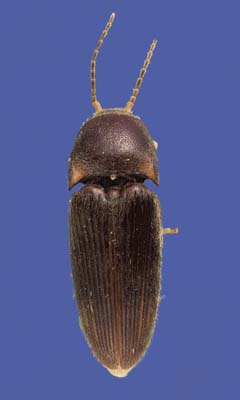Southern Potato Wireworm, Conoderus falli
Tobacco Wireworm, Conoderus vespertinus
(Coleoptera: Elateridae)
The southern potato wireworm and tobacco wireworm are distributed throughout the southeastern United States. Generally, there is one generation per year, and most insects overwinter in the larval stage and pupate from March to May. Eggs are spherical in shape and white. The larvae are initially white in color but become cream-colored or yellowish as they mature. The pupa is white to yellow with a tan head. Adults, which are commonly called click beetles, range from light to dark brown with tan legs. Adults are nocturnal and hide under organic material during the day.
Vegetable crops that are reported to be damaged under field conditions include cantaloupe, beet, cabbage, carrot, celery, corn, cowpea, mustard, potato, tomato, and turnip. Damage is caused primarily by the larvae feeding on roots, stems, tubers, and seeds of many plants. Larvae seem to prefer plant parts that are in direct contact with the soil. The larvae may cause considerable damage to irrigation systems by eating holes in plastic materials. Cultural control practices include cover crops, crop rotation, flooding, and host plant resistance. Granular insecticides are commonly used at planting to prevent damage to young plants by wireworm larvae. Detection of wireworm larvae in the soil may be accomplished by baiting. Some resistance to insecticides has been reported.
Images
To save the Web-optimized images shown below to your hard drive:
PC users: right click to "Save Picture (or Image) As..."
Mac users: click and drag to your desktop.
Copyright © 2005 University of Florida

